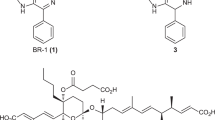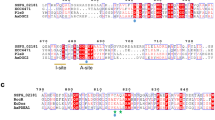Abstract
The γ-butyrolactone signaling system is distributed widely among streptomycetes as an important regulatory mechanism of antibiotic production and/or morphological differentiation. IM-2 [(2R,3R,1′R)-2-(1′-hydroxybutyl)-3-hydroxymethyl-γ-butanolide] is a γ-butyrolactone that switches off the production of d-cycloserine but switches on the production of several nucleoside antibiotics as well as blue pigment in Streptomyces lavendulae FRI-5. farX is a member of the afsA-family genes, which are proposed to encode enzymes involved in γ-butyrolactone biosynthesis. Disruption of farX caused overproduction of d-cycloserine, and abolished production of nucleoside antibiotic and blue pigment with the loss of IM-2 production. The finding that all phenotypic changes observed in the farX disruptant were restored by the addition of exogenous IM-2 suggested that FarX plays a biosynthetic role in IM-2 production. Transcriptional comparison between the wild-type strain and the farX disruptant revealed that, in addition to already known genes farR1 and farR2, several other genes (farR4, farD, and farE) are under the transcriptional regulation of IM-2. Furthermore, the fact that farX transcription is under the control of IM-2 suggested that S. lavendulae FRI-5 has a fine-tuning system to control γ-butyrolactone production.





Similar content being viewed by others
References
Arakawa K, Mochizuki S, Yamada K, Noma T, Kinashi H (2007) γ-Butyrolactone autoregulator receptor system involved in lankacidin and lankamycin production and morphological differentiation in Streptomyces rochei. Microbiology 153:1817–1827
Bierman M, Logan R, O’Brien K, Seno ET, Rao RN, Schoner BE (1992) Plasmid cloning vectors for the conjugal transfer of DNA from Escherichia coli to Streptomyces spp. Gene 116:43–49
Choi SU, Lee CK, Hwang YI, Kinosita H, Nihira T (2003) γ-Butyrolactone autoregulators and receptor proteins in non-Streptomyces actinomycetes producing commercially important secondary metabolites. Arch Microbiol 180:303–307
Hashimoto K, Nihira T, Sakuda S, Yamada Y (1992) IM-2, a butyrolactone autoregulator, induces production of several antibiotics in Streptomyces sp. FRI-5. J Ferment Bioeng 73:449–455
Horinouchi S (2007) Mining and polishing of the treasure trove in the bacterial genus Streptomyces. Biosci Biotechnol Biochem 71:283–299
Hsiao NH, Soding J, Linke D, Lange C, Hertweck C, Wohlleben W, Takano E (2007) ScbA from Streptomyces coelicolor A3(2) has homology to fatty acid synthases and is able to synthesize γ-butyrolactones. Microbiology 153:1394–1404
Kato JY, Miyahisa I, Mashiko M, Ohnishi Y, Horinouchi S (2004) A single target is sufficient to account for the biological effects of the A-factor receptor protein of Streptomyces griseus. J Bacteriol 186:2206–2211
Kato JY, Funa N, Watanabe H, Ohnishi Y, Horinouchi S (2007) Biosynthesis of γ-butyrolactone autoregulators that switch on secondary metabolism and morphological development in Streptomyces. Proc Natl Acad Sci USA 104:2378–2383
Kawachi R, Akashi T, Kamitani Y, Sy A, Wangchaisoonthorn U, Nihira T, Yamada Y (2000) Identification of an AfsA homologue (BarX) from Streptomyces virginiae as a pleiotropic regulator controlling autoregulator biosynthesis, virginiamycin biosynthesis and virginiamycin M1 resistance. Mol Microbiol 36:302–313
Kieser T, Bibb MJ, Buttner MJ, Chater KF, Hopwood DA (2000) Practical Streptomyces genetics. John Innes Foundation, Norwich
Kitani S, Kinoshita H, Nihira T, Yamada Y (1999) In vitro analysis of the butyrolactone autoregulator receptor protein (FarA) of Streptomyces lavendulae FRI-5 reveals that FarA acts as a DNA-binding transcriptional regulator that controls its own synthesis. J Bacteriol 181:5081–5084
Kitani S, Bibb M, Nihira T, Yamada Y (2000) Conjugal transfer of plasmid DNA from Escherichia coli to Streptomyces lavendulae FRI-5. J Microbiol Biotechnol 10:535–538
Kitani S, Yamada Y, Nihira T (2001) Gene replacement analysis of the butyrolactone autoregulator receptor (FarA) reveals that FarA acts as a novel regulator in secondary metabolism of Streptomyces lavendulae FRI-5. J Bacteriol 183:4357–4363
Kitani S, Iida A, Izumi TA, Maeda A, Yamada Y, Nihira T (2008) Identification of genes involved in the butyrolactone autoregulator cascade that modulates secondary metabolism in Streptomyces lavendulae FRI-5. Gene 425:9–16
Lee KM, Lee CK, Choi SU, Park HR, Hwang YI (2008) Functional analysis of a BarX homologue (SngA) as a pleiotropic regulator in Streptomyces natalensis. Arch Microbiol 189:569–577
Nihira T, Shimizu Y, Kim HS, Yamada Y (1988) Structure-activity relationships of virginiae butanolide C, an inducer of virginiamycin production in Streptomyces virginiae. J Antibiot (Tokyo) 41:1828–1837
Nishimura H, Mayama M, Komatsu Y, Kato H, Shimaoka N, Tanaka Y (1964) Showdomycin, a new antibiotic from Streptomyces sp. J Antibiot (Tokyo) 17:148–155
Paget MS, Chamberlin L, Atrih A, Foster SJ, Buttner MJ (1999) Evidence that the extracytoplasmic function sigma factor σE is required for normal cell wall structure in Streptomyces coelicolor A3(2). J Bacteriol 181:204–211
Sakuda S, Higashi A, Tanaka S, Nihira T, Yamada Y (1992) Biosynthesis of virginiae butanolide A, a butyrolactone autoregulator from Streptomyces. J Am Chem Soc 114:663–668
Sakuda S, Tanaka S, Mizuno K, Sukcharoen O, Nihira T, Yamada Y (1993) Biosynthetic studies on virginiae butanolide A, a butyrolactone autoregulator from Streptomyces. Part 2. Preparation of possible biosynthetic intermediates and conversion experiments in a cell-free system. J Chem Soc Perkin Trans 1:2309–2315
Sato K, Nihira T, Sakuda S, Yanagimoto M, Yamada Y (1989) Isolation and structure of a new butyrolactone autoregulator from Streptomyces sp. FRI-5. J Ferment Technol 68:170–173
Shikura N, Yamamura J, Nihira T (2002) barS1, a gene for biosynthesis of a γ-butyrolactone autoregulator, a microbial signaling molecule eliciting antibiotic production in Streptomyces species. J Bacteriol 184:5151–5157
Takano E (2006) γ-Butyrolactones: Streptomyces signalling molecules regulating antibiotic production and differentiation. Curr Opin Microbiol 9:287–294
Takano E, Nihira T, Hara Y, Jones JJ, Gershater CJ, Yamada Y, Bibb M (2000) Purification and structural determination of SCB1, a γ-butyrolactone that elicits antibiotic production in Streptomyces coelicolor A3(2). J Biol Chem 275:11010–11016
Takano E, Chakraburtty R, Nihira T, Yamada Y, Bibb MJ (2001) A complex role for the γ-butyrolactone SCB1 in regulating antibiotic production in Streptomyces coelicolor A3(2). Mol Microbiol 41:1015–1028
Takano E, Kinoshita H, Mersinias V, Bucca G, Hotchkiss G, Nihira T, Smith CP, Bibb M, Wohlleben W, Chater K (2005) A bacterial hormone (the SCB1) directly controls the expression of a pathway-specific regulatory gene in the cryptic type I polyketide biosynthetic gene cluster of Streptomyces coelicolor. Mol Microbiol 56:465–479
Waki M, Nihira T, Yamada Y (1997) Cloning and characterization of the gene (farA) encoding the receptor for an extracellular regulatory factor (IM-2) from Streptomyces sp. strain FRI-5. J Bacteriol 179:5131–5137
Yanagimoto M (1983) Novel actions of inducer in staphylomycin production by Streptomyces virginiae. J Ferment Technol 61:443–448
Yanagimoto M, Enatsu T (1983) Regulation of a blue pigment production by gamma-nonalactone in Streptomyces sp. J Ferment Technol 61:545–550
Yanagimoto M, Matsumoto K, Mori K (1988) IM2, a new inducer of blue pigment production in Streptomyces sp. MAFF 10-06015. J Ferment Technol 66:1–6
Acknowledgments
We thank Hiroshi Kinoshita for his helpful suggestions. This study was supported in part by the “Research Project in the Field of Biotechnology” under the Ministry of Education, Culture, Sports, Science, and Technology of Japan, the National Research Council of Thailand and the National Science and Technology Development Agency of Thailand to T.N.
Author information
Authors and Affiliations
Corresponding author
Additional information
Communicated by Jean-Luc Pernodet.
S. Kitani and M. Doi contributed equally to this work.
Electronic supplementary material
Below is the link to the electronic supplementary material.
Rights and permissions
About this article
Cite this article
Kitani, S., Doi, M., Shimizu, T. et al. Control of secondary metabolism by farX, which is involved in the γ-butyrolactone biosynthesis of Streptomyces lavendulae FRI-5. Arch Microbiol 192, 211–220 (2010). https://doi.org/10.1007/s00203-010-0550-3
Received:
Revised:
Accepted:
Published:
Issue Date:
DOI: https://doi.org/10.1007/s00203-010-0550-3




